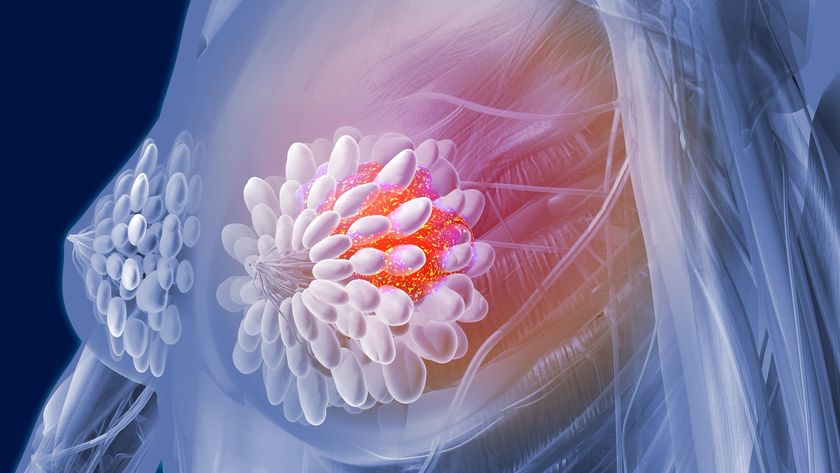Avastin's Failure in Breast Cancer: New Study May Explain Why It Happened

A new study may explain why the cancer drug Avastin hasn't worked in the treatment of breast cancer patients. Although the drug stops tumor growth for a short time, it often leads to more invasive tumors in the long run.
The reason for this revved-up invasiveness, researchers concluded from experiments done in mice, is that drugs like Avastin increase the portion of a tumor made of breast cancer stem cells.
Although Avastin, when initially given, causes some cancer cells to die and tumors to shrink, what's left behind are the cancer stem cells, according to the study. These cells can then multiply, and they are among the most lethal cancer cells — they can sprout new tumors more easily than run-of-the-mill cancer cells.
The finding suggests that clinicians could improve Avastin's effectiveness by blocking this unwanted effect of the drug. It's a potentially bright spot for the drug, after a November decision by the Food and Drug Administration that the drug should not be used to treat breast cancer after studies showed the drug failed to lengthen patient's lives.
"This result explains why they don't work as well as we hoped it would, and it really points to what we need to do to develop drug combinations that are more effective," said Dr. Max Wicha, author of the new study and an oncologist at the University of Michigan.
The new findings, which may also apply to other drugs in the same class as Avastin, were published Monday (Jan. 23) in Proceedings of the National Academy of Sciences.
The seeds of a tumor
Sign up for the Live Science daily newsletter now
Get the world’s most fascinating discoveries delivered straight to your inbox.
Avastin falls into a category of cancer drugs called antiangiogenic agents, which aim to work by blocking the growth of blood vessels that supply tumors with vital nutrients and oxygen. Without a blood supply, tumors will die, the thinking goes.
"There was a lot of excitement about using these drugs to block the blood supply to tumors," Wicha said. "But the first large studies showed that while Avastin seemed to be preventing tumors from progressing for a few months, the tumors would then start to grow again, and be even more aggressive."
Wicha said he and his colleagues suspected the cause of the new, aggressive growth, might be cancer stem cells. "These cells are the most dangerous, if they're left in the body," he explained. "They're like the seeds of a plant."
The researchers tested their theory by giving an antiangiogenic drug to mice with breast cancer tumors. As expected, the tumors shrank and had fewer blood vessels feeding them. When the team analyzed the cells within the tumors, however, the tumors of mice that had been treated with an antiangiogenic drug had five times more stem cells.
Further, the scientists found, the lack of oxygen — called hypoxia — in the tissues that followed the death of the blood vessels had the side effect of encouraging the growth of these dangerous cells. If doctors could combine drugs that kill the cancer stem cells with antiangiogenic drugs, they may have a winning formula, Wicha said.
"Our research suggests that it's going to necessary to target both angles of this at the same time," he said.
Two sides of a drug
The new findings didn't surprise Celeste Simon, a molecular biologist at the University of Pennsylvania School of Medicine who studies the role of the body's low oxygen environments to human health.
"Stem cells really like to reside in a low oxygen area," Simon said.
What the study adds, Simon said, is evidence that drugs like Avastin increase the pool of cancer stem cells living in these low-oxygen conditions.
"The notion is that by making the tumor more hypoxic, you're actually selecting for the more aggressive cells," she said. "This and other papers underscore a growing idea in the therapeutic world that, like all treatments, antiangiogenic drugs need to be very carefully evaluated in terms of their full impact on human health."
But more work is needed, she said, to flesh out the full molecular details of the observation. Tumors implanted into mice, such as the study used, aren't always a perfect mimic of human biology. "While these results are intriguing, they need to be followed up, from my point of view, with experiments on more sophisticated mouse models or primary tumors," Simon said.
Pass it on: Although Avastin successfully cuts off the blood supply of breast cancer tumors, it also increases the number of so-called breast cancer stem cells that can lead to tumor growth in the long run.
This story was provided by MyHealthNewsDaily, a sister site to LiveScience. Follow MyHealthNewsDaily on Twitter @MyHealth_MHND. Find us on Facebook.













